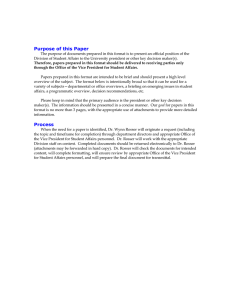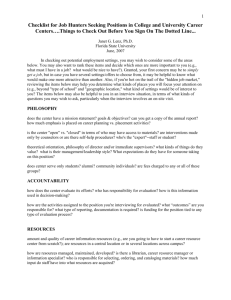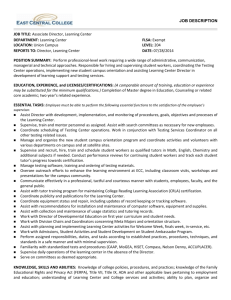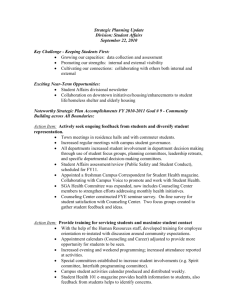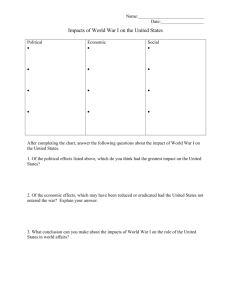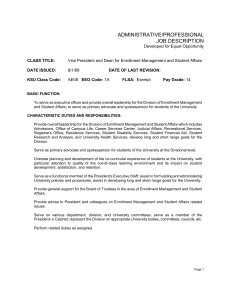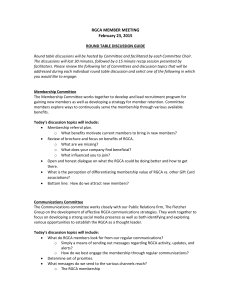Informational White Paper: The Department of Residence Life
advertisement
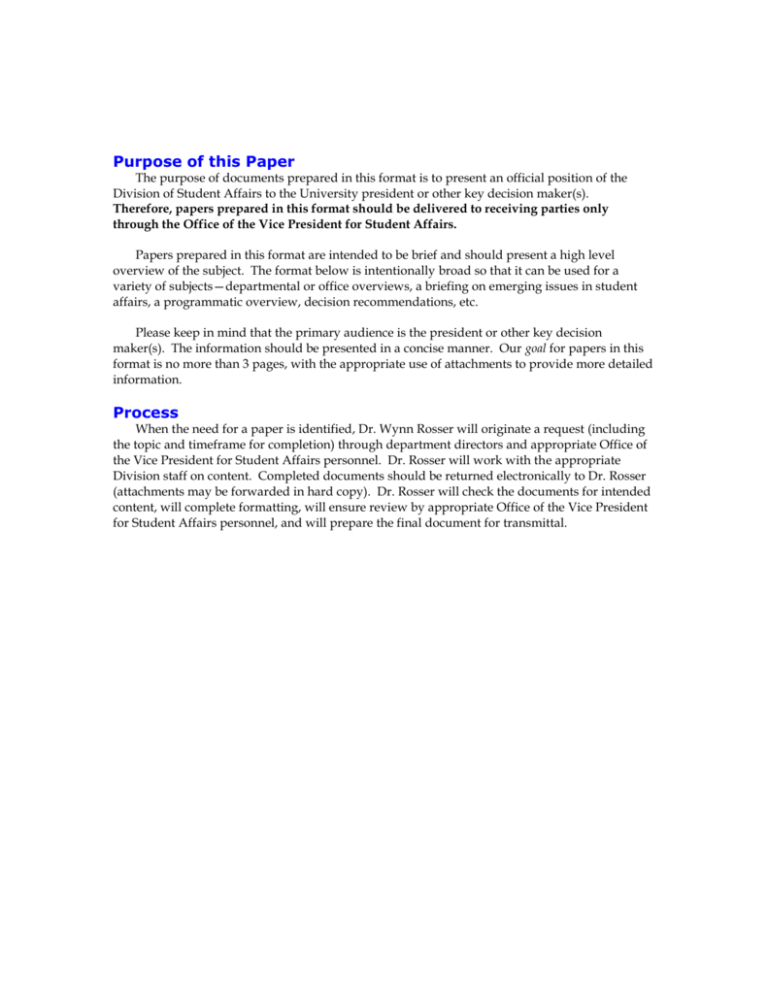
Purpose of this Paper The purpose of documents prepared in this format is to present an official position of the Division of Student Affairs to the University president or other key decision maker(s). Therefore, papers prepared in this format should be delivered to receiving parties only through the Office of the Vice President for Student Affairs. Papers prepared in this format are intended to be brief and should present a high level overview of the subject. The format below is intentionally broad so that it can be used for a variety of subjects—departmental or office overviews, a briefing on emerging issues in student affairs, a programmatic overview, decision recommendations, etc. Please keep in mind that the primary audience is the president or other key decision maker(s). The information should be presented in a concise manner. Our goal for papers in this format is no more than 3 pages, with the appropriate use of attachments to provide more detailed information. Process When the need for a paper is identified, Dr. Wynn Rosser will originate a request (including the topic and timeframe for completion) through department directors and appropriate Office of the Vice President for Student Affairs personnel. Dr. Rosser will work with the appropriate Division staff on content. Completed documents should be returned electronically to Dr. Rosser (attachments may be forwarded in hard copy). Dr. Rosser will check the documents for intended content, will complete formatting, will ensure review by appropriate Office of the Vice President for Student Affairs personnel, and will prepare the final document for transmittal. TEXAS A&M UNIVERSITY Office of the Vice President for Student Affairs 1256 TAMU College Station, Texas 77843-1256 (979) 845-4728 FAX (979) 845-3320 Higher Education Law And the University/student Relationship July 29, 2002 Introduction There are a multitude of legal relationships between Texas A&M University and the many constituents it serves. One of the most complex, far- reaching, and constantly evolving legal relationships is between the student and the university. This relationship will be the focus of this briefing document along with the impact of legislation and case law. The university/student relationship has evolved from in loco parentis, (in place of parent) to one that is comprised of multiple legal dimensions including constitutional rights, contractual rights, statutory protections, and where it can be demonstrated that the university is negligent, the right to recover damages. Students are afforded certain rights, privileges, and protections that are articulated in each of these dimensions. Case law contains the courts’ interpretation of the four general dimensions to this legal relationship; provides insight into the associated legal duties, constraints and potential liabilities; and (along with federal regulations) gives direction for making decisions regarding practices, protocols, rules, regulations, and policies. Examples of decisions that affect the university/student relationship include: disability accommodations in and outside the classroom; decisions about privacy and/or sharing of student records; due process and equal protection rights in judicial affairs; rate, refund and assignment termination decisions in the residence halls; responding to complaints of sexual harassment; residence hall room searches; racial and gender discrimination complaints; reporting prescribed occurrences of campus crime; student protests; and the right of students to associate by forming student organizations. Background The four dimensions of the university/student relationship are: The constitutional dimension: In their relationships with public institutions, students’ constitutional rights are not absolute, but they are guaranteed. These include rights delineated in several of the amendments to the United States Constitution including the first (freedom of religion, speech, press, and assembly); the fourth (protection against unreasonable search and seizure); and the fourteenth (due process and equal protection). Each of these rights have been carefully examined, explored, and explained in case law that will be discussed as a part of this paper. By contrast, students at private institutions generally have no guarantee of constitutional rights in their relationship with the institution. Any rights given to students at private institutions are provided contractually-- not constitutionally. Court cases that are often cited to illuminate the university/student constitutional dimension include: Dixon v. Alabama State Board of Education, 294 F. 2d 150 (5th Cir. 1961). Established that students shall, prior to suspension or expulsion, be afforded due process rights to include: notice of specific charges, an opportunity to be heard, names of witnesses, oral or written report of the facts to which each witness testifies, and an opportunity to present a defense. Tinker v. Des Moines Independent Community School District, 393 U.S. 503 (1969). Reiterated students’ right to free speech in their relationship with a secondary school. The Supreme Court stated: “It can hardly be argued that either students or teachers shed their constitutional rights to freedom of speech or expression at the schoolhouse gate.” Also emphasized that the freedom to protest does not create a freedom to disrupt. Healy v. James, 92 S Ct. 2338 (1972). Using Tinker as a foundation, the Supreme Court noted the significance of the First Amendment at state colleges and universities: “State colleges and universities are not enclaves immune from the sweep of the First Amendment . . . the precedents of this Court leave no room for the view that. . . First Amendment protections should apply with less force on college campuses than in the community at large.” The Supreme Court went on to note that “The college classroom with its surrounding environs is peculiarly the “marketplace of ideas,”. . . (Note: The “marketplace of ideas” concept is frequently referenced in academic freedom discussions.) The court went on to indicate that public institutions may adopt reasonable regulations with respect to time, place, and manner of speech related activities. Widmar v. Vincent, 454 U.S. 263 (1981). A university regulation that prohibited the use of university buildings or grounds “for purposes of religious worship or religious teaching” was declared an unconstitutional content-based restriction on religious free speech. Papish v. Board of Curators of University of Missouri, 93 S. Ct. 1197 (1973). Student newspaper editor was expelled for violating board of curators bylaw prohibiting distribution of newspapers “containing forms of indecent speech.” The newspaper contained a political cartoon that depicted policemen raping the Statue of Liberty and the Goddess of Justice with a caption that read: “With Liberty and Justice for All.” Additionally the newspaper contained an article entitled “M_______ F_____ Acquitted.” The student successfully sued the university. Ruling in the student’s favor the Supreme Court stated: . . . “Healy v. James makes it clear that the mere dissemination of ideas – no matter how offensive to good taste – on a state university campus may not be shut off in the name alone of conventions of decency.” The contractual dimension: In their relationship with the university, students have rights and responsibilities that are created contractually. The elements of a contract are offer, acceptance, and consideration. Examples of the contractual relationship between students and the university include housing contracts, dining service contracts, class syllabi, course catalogs, and loan agreements. Court case that is often cited to illuminate the university/student contractual dimension: Steinberg v. Chicago Medical College, 371 N.E. 2d 634 (Ill. 1977). The court asserted a contractual duty to judge applicants’ qualifications only by criteria published in the school catalog. The college had used alternative criteria and the courts found in favor of the student by recognizing the contractual relationship between the student and the college based on language contained in the college catalog. Court finding : college catalogs may constitute a valid contract. The statutory dimension: Federal statutes are triggered when the institution accepts federal funding. Among the many outcomes of these federal statues is the creation of protected classes: race, color, religion, sex, national origin, and disabled. The effect for individuals contained in each class is protection that prohibits discrimination against members of the protected class, and insures access to, federally funded programs for individuals in the protected class. Policies, rules, protocols, and practices have been written with these protected classes in mind. Examples of these federal statutes include: Title VI of the Civil Rights Act of 1964 – prohibits discrimination based on race, color, or national origin in federally funded programs Title VII of the Civil Rights Act of 1964 – prohibits discrimination based on race, color, religion, sex, or national origin in hiring practices in federally funded programs (Workplace “hostile environment” sexual harassment charges have a Title VII legal foundation) Title IX of the Educational Amendments of 1972 – requires equal access by sex to federally funded educational programs (student-onstudent sexual harassment charges have a Title IX legal foundation) Section 504 of the Rehabilitation Act of 1974 – provides that no otherwise qualified individual with a disability shall be excluded from participation or be subjected to discrimination in federally funded programs The Family Educational Rights and Privacy Act of 1974 (FERPA) – provides for privacy of student records and right to review those records by the student. Records that are protected are all those records that are directly related to a student and maintained by an educational agency. FERPA requires that generally, records cannot be released without the written permission of the student, except to the parent or guardian of dependent students. Also allows for notification of parent/guardian of students who are under 21 and in violation of alcohol and/or drug policies. Student records can be shared internally. Directory information (name, address, telephone number, height, weight, photographic image, etc.) may be published unless the student expressly requests otherwise. The Civil Right Restoration Act of 1987 - Established that if a college or university receives any amount of federal funding the entire institution is considered a federally funded program. The Drug Free Schools and Communities Act Amendments of 1989 – Requires annual distribution to each student and employee of: Standards of Conduct; a clear statement that the institution will impose disciplinary sanctions for alcohol and drug violations; a description of state, local and federal laws; a description of health risks associated with alcohol and drugs; and a description of counseling and rehabilitation programs. Additional requirements include a biennial review by the institution of its alcohol and drug programs to: determine their effectiveness and implement changes if necessary, and to ensure that the disciplinary sanctions are consistently enforced. The Americans with Disabilities Act (1990)– Requires access for the disabled to federally funded programs. Institutions are only required to accommodate those disabilities of which they are aware. However, they must make reasonable (as defined in federal regulations and case law) accommodations when they are made aware. Obvious and visible disabilities create awareness. Examples of reasonable accommodations include the following: facilities used by the disabled must be readily accessible and usable, acquisition and modification of equipment or devices to facilitate participation, and modification of exams or policies. The Campus Security Act (1990) – Requires a campus security report that contains information about the following: procedures to report crimes, policies for responding to these reports, information about security of and access to campus facilities, arrest authority of campus police, policies to encourage prompt reporting, programs to inform about crime and take personal responsibility for safety, and programs on crime prevention. Requires reporting statistics on the occurrence of the following: criminal homicide (murder, non-negligent manslaughter, negligent manslaughter), sex offenses (forcible sex offenses and non-forcible sex offenses), robbery, aggravated assault, burglary, motor vehicle theft, and arson. Also requires reporting statistics on arrests and referrals for disciplinary action on: liquor law violations, drug law violations, and illegal weapons possession. Further requires that institutions have policies to respond to underage drinking, policies to respond to drug possession and use, and a method for monitoring and recording criminal activity at offcampus locations of recognized student groups Health Insurance Portability and Accountability Act - HIPPA (Effective 2003) – Requires that medical information be collected in a uniform manner to allow for portability of records. Further requires that medical information be kept confidential and allows for criminal and civil penalties for breaches of confidence. Tort dimension: Liability can arise in two main areas: defamation and negligence. Defamation occurs when person A communicates to person B something about person C that is untrue and that brings harm to their reputation. Oral communication that meets this criteria is slander, the written form is libel. Negligence occurs when a court determines that four conditions have been met. There must be a duty, a breach of that duty, an injury, and linkage between the breach and the injury. There are four common law duties that exist under the overall duty of care. The duties are: to train, to supervise, to maintain equipment and property, and to warn of impending danger. Court cases that are often cited to illuminate the university/student tort dimension include: Mullins v. Pine Manor College, 449 N.E. 2d 331 (Mass. 1983). College was found negligent in meeting duty of care for residential student who was kidnapped from her residence hall room, forced to walk across campus with pillow case over her head, and subsequently raped. Testimony revealed that college had security guards who were poorly trained and insufficiently supervised, policies that were not followed, and security features that were not effective. Duties to train, to supervise, and to maintain equipment and property were breached, student was injured and courts found there to be causation (linkage) between the breach of the duties and the injuries suffered by the student. Tarasoff v. Regents of the University of California, 551 P. 2d. 334 (Cal. 1976). Tarasoff was killed by male student who had confided his desire to harm her to his university psychotherapist. Psychotherapist notified police who contacted the male student, questioned and released him. Neither police or psychotherapist contacted Tarasoff to alert her to possible danger. Male student accosted Tarasoff and killed her. The Tarasoff estate successfully sued the university. Court found that that university had a duty to warn Tarasoff of impending danger Mintz v. State, 362 N.Y.S. 2d 619 (S. Ct. App. Div., 3 rd Dept. 1975). University could not be held liable for deaths of college students who drowned in a fierce and unexpected storm on a lake while participating in an overnight canoe outing. The university demonstrated reasonable care in meeting duties by taking numerous precautions. They reviewed the weather report which indicated no unusual weather patterns, placed experienced canoeists in each canoe, provided appropriate safety equipment, ensured that canoes were escorted by a motorboat, provided canoes with lights, and placed a flashing beacon at the destination point as a navigational aid. Because the university met each of their duties there was no finding of negligence. Federal and state law, federal regulations, classic and current case law, the legal climate, and emerging legal issues represent the body of knowledge necessary for effective decision making in the higher education legal environment and more specifically university/student relationship issues. Faculty and Staff have a responsibility to afford these rights and protections to students. In the alternative, they place the university and themselves in a position of legal vulnerability. The nature of student affairs functions and responsibilities coupled with the need for effective policy, rule, and protocol development requires an in-depth knowledge of the rights, privileges, and protections afforded to students by: the constitution, contracts, statutes and tort law. There are a variety of means through which rights, privileges and protections for students are administered. These include program areas, policies, rules, and protocols. Specific examples include: due process protections in adjudication of student rule violations, free speech zones, student protest protocols, residence hall room entry policies, FERPA protocols in various offices, gender equity policies, reporting of the annual summary of campus crimes, housing contracts, dining contracts, sexual harassment policies and protocols, and risk management initiatives. Impact on Key Constituency Groups Key Issues Action Items Resource Implications Benefit to Texas A&M University Additional Information For additional information please contact: Dr. Bill Kibler, Associate Vice President for Student Affairs Dr. Dave Parrott, Dean of Student Life Attachments
